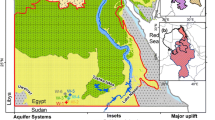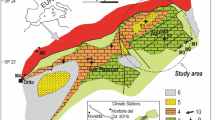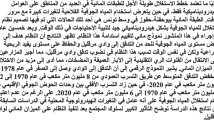Abstract
In recent years, geochemical and geophysical studies have challenged the commonly held view that the use of fossil Sahara aquifers is completely unsustainable because they have not been recharged since the last wet period of the Holocene. Here, we use gravity data and groundwater flow modeling to provide further evidence of modern recharge of the North-Western Sahara Aquifer System (NWSAS, Algeria, Tunisia, and Libya). The rainfall-recharge relationship previously established using data from the Gravity Recovery and Climate Experiment (GRACE) allows to produce a time series of the cumulated recharge of the NWSAS between 1950 and 2016. This reconstruction yields a mean value of 1.3 km3 year−1 while a near-zero recharge is obtained using GRACE data for the current decade. According to our hydrogeological model, the recharge of the confined aquifer amounts to 0.3 km3 year−1, representing almost 25% of the overall recharge. Comparison with the time evolution of pumping rates reveals that unsustainable exploitation came fully into effect around 1980, causing a tremendous decline in natural outflows. We show here that the natural outflow of the deep aquifer at Gabès (Tunisia), which partly sustains the coastal aquifer of the Djeffara plain, will vanish in the coming decade, highlighting unsustainable aquifer exploitation. Current population growth and climate change projections are both leading to a degree of groundwater over-exploitation which can only become increasingly unsustainable. Only the enforced regulation of irrigation practices supported both by current oasis pilot experiments and future fully integrated hydro-economic models will be effective in limiting this evolution.





Similar content being viewed by others
References
Abid K, Dulinski M, Ammar FH, Rozanski K, Zouari K (2012) Deciphering interaction of regional aquifers in southern Tunisia using hydrochemistry and isotopic tools. Appl Geochem 27:44–55. https://doi.org/10.1016/j.apgeochem.2011.08.015
Baba Sy M (2005) Recharge et paléorecharge du systèmeaquifère du Sahara Septentrional. PhD Thesis, Université of Tunis, Tunis, Tunisia
Ben Alaya M, Zemni T, Mamou A, Zargouni F (2014) Acquisition de salinité et qualité des eaux d’une nappe profonde, Tunisie: approche statistique et géochimique. Hydrolog Sci J 59:395–419. https://doi.org/10.1080/02626667.2013.870663
Besbes M, Horriche J (2007) Design of a piezometric monitoring network for the North Western Sahara aquifer system. Sécheresse 18:13–22. https://doi.org/10.1684/sec.2007.0062
Carter RC, Parker A (2009) Climate change, population trends and groundwater in Africa. Hydrolog Sci J 54:676–689. https://doi.org/10.1623/hysj.54.4.676
Carvalho Resende T, Longuevergne L, Gurdak JJ, Leblanc M, Favreau G, Ansems N, Van der Gun J, Gaye CB, Aureli A (2019) Assessment of the impacts of climate variability on total water storageacross Africa: implications for groundwater resources management. Hydrogeol J 27:493–512. https://doi.org/10.1007/s10040-018-1864-5
Chiang WH, Kinzelbach W (2001) 3D groundwater modeling with PMWIN: a simulation system for modelling groundwater flow and pollution. Springer, New-York
Chulli A, Tizro AT, Jabnoun N. (2007) Modélisation de l’intrusion marine dansl’aquifère côtier de Gabès (sudtunisien).In: Proceedings of Symposium « A New Focus on Groundwater–Seawater Interactions »,Perugia, Italy, IAHS Publ. 312.https://iahs.info/uploads/dms/13946.32-219-226-312_07_Chulli.pdf. Assessed 20 August 2019
Dalin C, Wada Y, Kastner T, Pum MJ (2017) Groundwater depletion embedded in international food trade. Nature 543:700–704. https://doi.org/10.1038/nature21403
Döll P, Fiedler K (2008) Global-scale modeling of groundwater recharge. Hydrol Earth Syst Sci 12:863–885. https://doi.org/10.5194/hess-12-863-2008
Edmunds WM, Guendouz AH, Mamou A, Moulla A, Shands P, Zouari K (2003) Groundwater evolution in the “Continental Intercalaire” aquifer of southern Algeria and Tunisia: trace element and isotopic indicators. Appl Geochem 18:805–822. https://doi.org/10.1016/S0883-2927(02)00189-0
ERESS (1972a) Etude des Ressources en Eau du Sahara Septentrional. Rapport final, 78p, plaquette 2: La nappe du continental Intercalaire-modèle mathématique, 1 carte; 12 planches, UNESCO, Paris
ERESS (1972b) Etude des Ressources en Eau du Sahara Septentrional. Rapport final, 78p, plaquette 4: Nappe de la zone côtière du sud tunisien (Djeffara) – Modèle analogique, 5 carte; 1 planche. UNESCO, Paris
Gleeson T, Wada Y, Bierkens MFP, van Beek LPH (2012) Water balance of global aquifers revealed by groundwater footprint. Nature 488:197–200. https://doi.org/10.1038/nature11295
Gonçalves J, Pagel M, Violette S, Guillocheau F, Robin C (2010) Fluid inclusions as constraints in a three-dimensional hydro-thermo-mechanical model of the Paris basin, France. Basin Res 22:699–716. https://doi.org/10.1111/j.1365-2117.2009.00428.x
Gonçalvès J, Petersen J, Deschamps P, Hamelin B, Baba-Sy O (2013) Quantifying the modern recharge of the “fossil” Sahara aquifers. Geophys Res Lett 40:2673–2678. https://doi.org/10.1002/grl.50478
Gonçalvès J, Vallet-Coulomb C, Petersen J, Hamelin B, Deschamps P (2015) Declining water budget in a deep regional aquifer assessed by geostatistical simulations of stable isotopes: case study of the Saharan –“Continental Intercalaire”. J Hydrol 531:821–829. https://doi.org/10.1016/j.jhydrol.2015.10.044
Gonfiantini R, Conrad G, Fontes J-Ch, Sauzay G, Payne BR (1974) Etude isotopique de la nappe du CI et ses relations avec les autres nappes du Sahara Septentrional. In: Proceedings of symposium isotope hydrology, Vienna. IAEA, Vienna, pp 227–241
Guendouz A, Moulla AS, Edmunds WM, Zouari K, Shand P, Mamou A (2003) Hydrogeochemical and isotopic evolution of water in the “complexe terminal” aquifer in the Algerian Sahara. Hydrogeol J 11:483–495. https://doi.org/10.1007/s10040-003-0263-7
Guendouz A, Michelot JL (2006) Chlorine-36 dating of deep groundwater from northern Sahara. J Hydrol 328:572–580. https://doi.org/10.1016/j.jhydrol.2006.01.002
Harou J, Pulido-Velasquez M, Rosenberg DE, Medellin-Azuara J, Lund JR, Howitt RE (2009) Hydro-economic models: concepts, design, applications, and future prospects. J Hydrol 375:627–643. https://doi.org/10.1016/j.jhydrol.2009.06.037
MacDonald AM, Bonsor HC, Dochartaigh BÉÓ, Taylor RG (2012) Quantitative maps of groundwater resources in Africa. Environ Res Lett 7:024009. https://doi.org/10.1088/1748-9326/7/2/024009
Mohamed A, Sultan M, Ahmed M, Yan E, Ezzat Ahmed E (2017) Aquifer recharge, depletion, and connectivity: inferences from GRACE, land surface models, and geochemical and geophysical data. GSA Bull 129:534–546. https://doi.org/10.1130/B31460.1
Moulla AS, Guendouz A, Cherchali MEH, Chaid Z, Ouarezki S (2012) Updated geochemical and isotopic data from the Continental Intercalaire aquifer in the great occidental erg sub-basin (South-Western Algeria). Quaternary Int 257:64–73. https://doi.org/10.1016/j.quaint.2011.08.038
Nicholson SE (2000) The nature of rainfall variability over Africa on time scales of decades to millennia. Glob Planet Change 26:137–158. https://doi.org/10.1016/S0921-8181(00)00040-0
OSS (2003) Système aquifère du Sahara Septentrional, Hydrogéologie, Volume II. Report, OSS, Tunis, Tunisia, 322pp
OSS (2006) Etude hydrogéologique du système aquifère de la Jeffara Tuniso- Lybienne. Report, OSS, Tunis, Tunisia, 210pp
Petersen JO, Deschamps P, Goncalvès J, Hamelin B, Michelot J-L, Guendouz A, Zouari K (2014) Quantifying paleorecharge in the “Continental Intercalaire” (CI) aquifer by a Monte-Carlo inversion approach of data. Appl Geochem 50:209–221. https://doi.org/10.1016/j.apgeochem.2014.04.014
Petersen JO, Deschamps P, Hamelin B, Fourre E, Goncalvès J, Zouari K, Guendouz A, Michelot JL, Massault M, Dapoigny A, Team A (2018) Groundwater flowpaths and residence times inferred by 14C, 36Cl and 4He isotopes in the “Continental Intercalaire” aquifer (North-Western Africa). J Hydrol 560:11–23. https://doi.org/10.1016/j.jhydrol.2018.03.003
Rodell M, Houser PR, Jambor U, Gottschalck J, Mitchell K, Meng C-J, Arsenault K, Cosgrove B, Radakovich J, Bosilovich M, Entin JK, Walker JP, Lohmann D, Toll D (2004) The global land data assimilation system. Bull Am Meteorol Soc 85:381–394. https://doi.org/10.1175/BAMS-85-3-381
Scanlon BR, Keese KE, Flint AL, Flint LE, Gaye CB, Edmunds WM, Simmers I (2006) Global synthesis of groundwater recharge in semiarid and arid regions. Hydrol Process 20:3335–3370. https://doi.org/10.1002/hyp.6335
Taylor RG, Koussis AD, Tindimugaya C (2009) Groundwater and climate in Africa-a review. Hydrol Sci J 54:655–664. https://doi.org/10.1623/hysj.54.4.655
Taylor RG, Scanlon B, Doll P, Rodell M, van Beek R, Wada Y, Longuevergne L, Leblanc M, Famiglietti JS, Edmunds M, Konikow L, Green TR, Chen J, Taniguchi M, Bierkens MFP, MacDonald A, Fan Y, Maxwell RM, Yechieli Y, Gurdak JJ, Allen DM, Shamsudduha M, Hiscock K, Yeh PJF, Holman I, Treidel H (2013) Ground water and climate change. Nature Clim Change 3:322–329. https://doi.org/10.1038/nclimate1744
Wada Y, Wisser D, Bierkens MFP (2014) Global modeling of withdrawal, allocation and consumptive use of surface water and groundwater resources. Earth Syst Dynam 5: 15-40. Doi:https://doi.org/10.5194/esd-5-15-2014. doi: https://doi.org/10.5194/esd-5-15-2014
Zammouri M, Ribeiro L (2017) Analyzing the effect of transmissivity uncertainty on the reliability of a model of the northwestern Sahara aquifer system. J Afr Earth Sci 129:910–922. https://doi.org/10.1016/j.jafrearsci.2017.02.034
Acknowledgments
The CEREGE group is supported by the LABEX OT-Med (Objectif Terre: Bassin Méditerranéen; http://www.otmed.fr/) and the Agence Nationale de la Recherche through the EQUIPEX ASTER CEREGE Project. Financial support from SICMED-MISTRAL is also acknowledged. The two anonymous reviewers as well as the Editors are acknowledged for their valuable and constructive comments.
Author information
Authors and Affiliations
Corresponding author
Additional information
Publisher’s note
Springer Nature remains neutral with regard to jurisdictional claims in published maps and institutional affiliations.
This article is part of the Topical Collection on Climate change impacts in the Mediterranean
Electronic supplementary material
ESM 1
(PDF 230 kb)
Rights and permissions
About this article
Cite this article
Gonçalvès, J., Deschamps, P., Hamelin, B. et al. Revisiting recharge and sustainability of the North-Western Sahara aquifers. Reg Environ Change 20, 47 (2020). https://doi.org/10.1007/s10113-020-01627-4
Received:
Accepted:
Published:
DOI: https://doi.org/10.1007/s10113-020-01627-4




